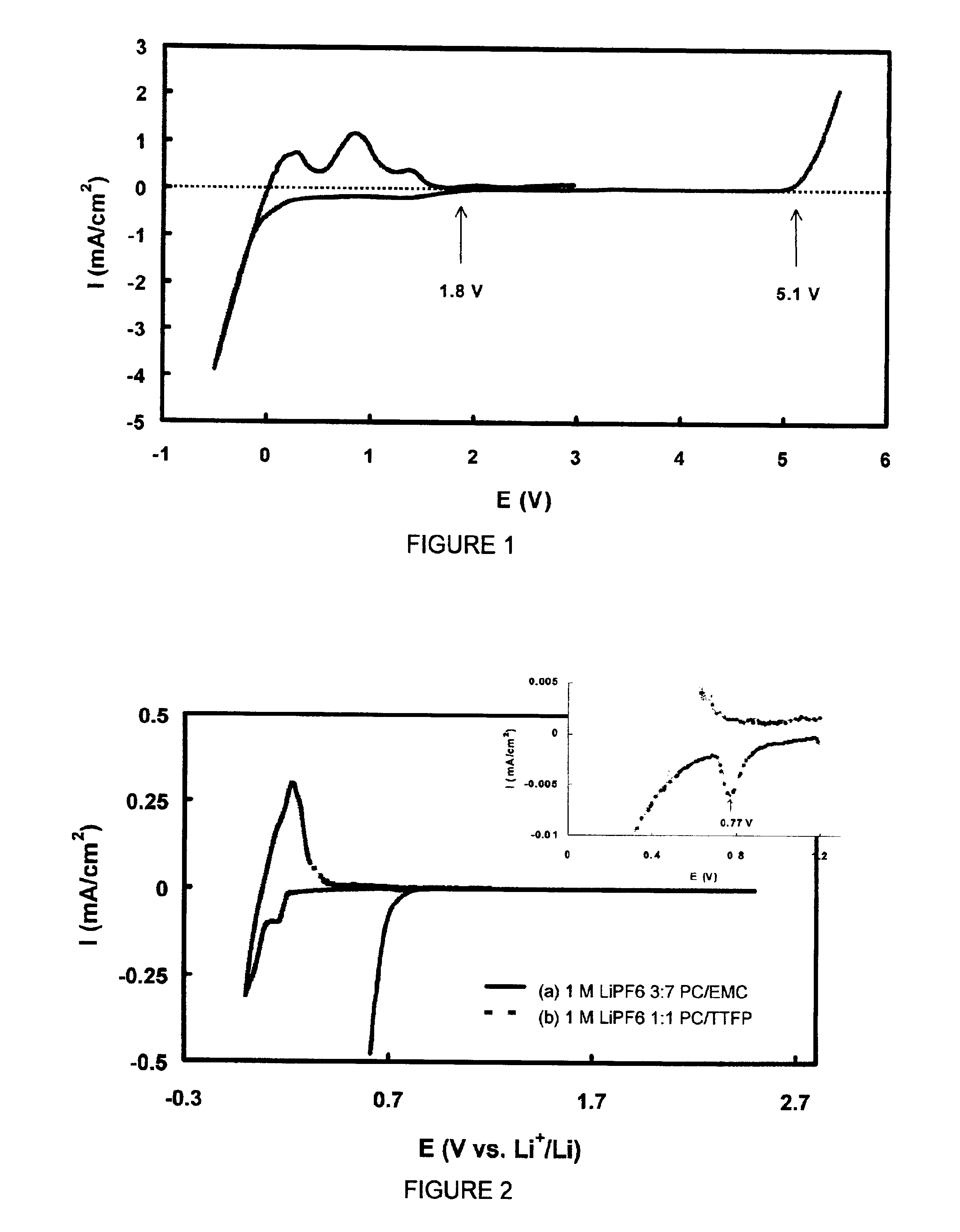Non-aqueous electrolyte solutions and non-aqueous electrolyte cells comprising the same
a technology of non-aqueous electrolyte and electrolyte, which is applied in the direction of non-aqueous electrolyte cells, cell components, electrochemical generators, etc., can solve the problems of incompatibility of graphite negative electrodes of li-ion batteries with pc-based electrolytes, and achieve high discharge/charge efficiency, high voltage, and high discharge capacity
- Summary
- Abstract
- Description
- Claims
- Application Information
AI Technical Summary
Benefits of technology
Problems solved by technology
Method used
Image
Examples
example 1
Stability of TTFP with Respect to Platinum (Pt) Electrode
[0043]The stability of TTFP with respect to a Pt electrode was evaluated using a cyclic voltammetry technique at a potential scan rate of 5 mV / s. The working electrode was a Pt foil with an area of 8×8 mm. Both the counter and reference electrodes were lithium metal. The electrolyte used was a 1 m LiPF6 / PC-TTFP (1:1 weight ratio) solution. The voltammogram as shown in FIG. 1 indicates that with respect to Pt, the TTFP is stable up to 5.1 V in the oxidative side and starts a reductive reaction at about 1.8 V. This figure also indicates that current density of the reductive reaction is depressed at a level of 0.7 mA / cm2, until metal lithium starts to deposit at much lower potential.
example 2
Stability of 1 m LiPF6 / PC-EMC (3:7 wt Ratio) Electrolyte and 1 m LiPF6 / PC-TTFP (1:1 wt Ratio) Electrolyte with Respect to Graphite Electrode
[0044]Two identical Li / graphite cells with an electrode area of 6 cm2 were assembled. The first cell was filled with 1 m LiPF6 / PC-EMC (3:7 wt ratio) electrolyte, and the second cell was filled with 1 m LiPF6 / PC-TTFP (1:1 wt ratio) electrolyte. The stability of the electrolyte was tested using a cyclic voltammetry technique at a scanning rate of 0.01 mV / s between 2.5 V and 0 V. Cyclic voltammogram of the first cell is shown as curve (a) in FIG. 2. When the potential was scanned down to 0.8 V vs. Li+ / Li, a sharp increase in the cathodic current was found. The experiment was terminated at around 0.6 V because of too large current. A cyclic voltammogram of the second cell is shown as curve (b) in FIG. 2. The sharp increase in the cathodic current only started at below 0.2 V, and finally formed a pair of redox current peaks with an coulomb efficiency...
example 3
Discharge of Graphite Electrode in 1 m LiPF6 / PC-EMC (3:7 wt Ratio) Electrolyte and in 1 m LiPF6 / PC-TTFP (1:1 wt Ratio) Electrolyte
[0045]Two identical Li / graphite cells were assembled in the same manner as described in Example 2. The first cell was filled with 1 M LiPF6 / PC-EMC (3:7 wt ratio) electrolyte and the second cell was filled with 1 M LiPF6 / PC-TTFP (1:1 wt ratio) electrolyte. Both cells were discharged from open-circuit voltage (OCV) at a constant current density of 0.093 mA / cm2. The voltage of the first cell, as shown in curve (a) in FIG. 3, was shortly decreased to 0.8 V from OCV and indefinitely retained at around 0.8 V. The voltage of the second cell was able to discharge to 0.002 V and then charged back to 1.0 V at the same 0.093 mA / cm2. Curve (b) of FIG. 3 indicates a coulomb efficiency of 88% for the first intercalation and de-intercalation of Li ions into the graphite electrode. This example demonstrates that the addition of TTFP into PC could prevent the decompositio...
PUM
 Login to View More
Login to View More Abstract
Description
Claims
Application Information
 Login to View More
Login to View More - R&D
- Intellectual Property
- Life Sciences
- Materials
- Tech Scout
- Unparalleled Data Quality
- Higher Quality Content
- 60% Fewer Hallucinations
Browse by: Latest US Patents, China's latest patents, Technical Efficacy Thesaurus, Application Domain, Technology Topic, Popular Technical Reports.
© 2025 PatSnap. All rights reserved.Legal|Privacy policy|Modern Slavery Act Transparency Statement|Sitemap|About US| Contact US: help@patsnap.com



